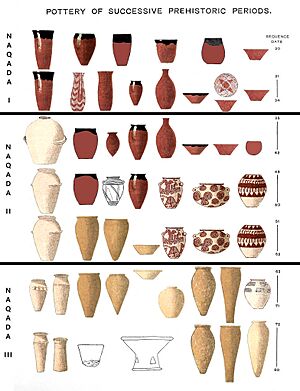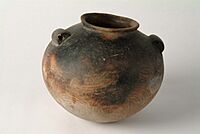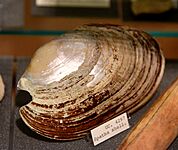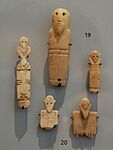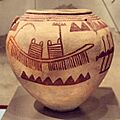Naqada culture facts for kids
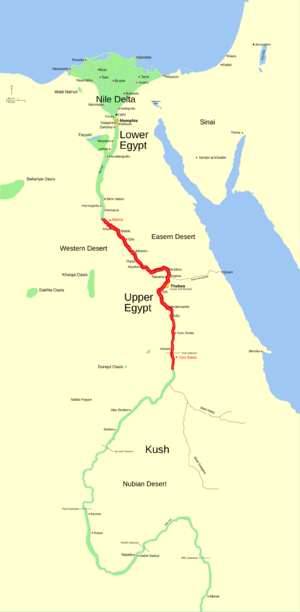
Extent of Naqada I culture
|
|
| Geographical range | Egypt |
|---|---|
| Period | Neolithic |
| Dates | c. 4000–3000 BC |
| Type site | Naqada |
| Preceded by | Badarian culture |
| Followed by | Protodynastic Period |
The Naqada culture was an important ancient civilization in Predynastic Egypt. It existed from around 4000 to 3000 BC. This culture is named after the town of Naqada in Egypt. Scientists have used radiocarbon dating to figure out that it started between 3800 and 3700 BC.
The Naqada culture was part of the Chalcolithic period. This means people used both stone and early metal tools. The very last part of the Naqada culture, called Naqada III, happened at the same time as the Protodynastic Period. This was a time when Egypt was just starting to form into one big kingdom.
Contents
Understanding the Naqada Time Periods
Scientists have divided the Naqada culture into different time periods. This helps us understand how the culture changed over many years.
Early Discoveries by William Flinders Petrie
A British expert on Egypt, William Matthew Flinders Petrie, first studied the Naqada area in 1894. He divided the Naqada period into three main parts:
- Naqada I: Also called the Amratian period.
- Naqada II: Also called the Gerzean period.
- Naqada III: Also called the Semainean period.
Werner Kaiser's Modern Timeline
Later, in 1957, another Egyptologist named Werner Kaiser created a new timeline. This timeline is still used today, with a few small changes. Here's what each period was like:
- Naqada I (about 3900–3650 BC):
- People made pottery that was black on top and often painted.
- They traded with people in Nubia (south of Egypt). They also traded with people in the Western Desert and the Eastern Mediterranean.
- They got a special volcanic glass called obsidian from Ethiopia. They used it to make sharp tools.
- Naqada II (about 3650–3300 BC):
- This culture spread across almost all of Egypt.
- People started making pottery from a different type of clay called marl. They also began working with metals more.
- Naqada III (about 3300–2900 BC):
Daily Life and Creations of the Naqada People
The Naqada people created many interesting things. These items tell us a lot about their daily lives, art, and beliefs.
Pottery and Art
Pottery was very important to the Naqada culture. Each period had its own special pottery styles. They made bowls, jars, bottles, and even wine jars. Many pots were used for storing food or for eating. Some pottery had beautiful decorations. These designs often included waves, flowers, or drawings of people. This shows how important art was to them. Some designs, like griffins and serpent-headed panthers, might have been influenced by art from Mesopotamia.
-
A jar from the Late Naqada II period, now in the Metropolitan Museum of Art.
Tools and Hunting
The Naqada people made tools from different materials. Copper harpoons were made at some Naqada III sites. These harpoons were mainly used for hunting large animals like hippopotamuses in the Nile River. Hunting hippos was seen as a sign of high social status. Copper was mostly available to the rich people. Harpoons might also have been used for protection during trade journeys. They also appeared in art, possibly for religious reasons or to show magical hunts.
Figurines and Beliefs
Small figures made from stone and ivory have been found at Naqada sites. These figurines might have been toys for children. They could also have been used for rituals, like for medicine or magic. Some experts think they were worshiped as idols to help with farming and good harvests. Many figurines were found near bodies in tombs. This suggests they were used in burial ceremonies.
-
A bone figure of a woman from Naqada I, now in the British Museum.
-
An ivory figurine of a man from the Late Naqada I period, at the Metropolitan Museum of Art.
Knives and Their Uses
Knives were very common in the Naqada culture. A special style of knife, called the "Twisted-knife," started in northern Egypt. It then spread to southern Egypt, mixing different knife-making styles. These knives were usually made from flint. Knife handles from the Naqada II period often had detailed carvings. These carvings showed people worshiping or scenes from nature. Knives were used for everyday tasks like cutting food and hunting. Fancy knives with decorated handles were probably only for the wealthy people.
-
A Fishtail Knife from the Naqada II period, at the Metropolitan Museum of Art.
-
The Gebel el-Arak Knife, from the Musée du Louvre (3300-3200 BCE).
Early Writing
Early forms of Egyptian writing appeared during the Naqada culture. This writing started around the Naqada II period. It used pictures, called pictograms. Many artifacts, especially vessels, show this early writing. The pictures usually showed animals and people. This writing was used to keep records of trade and business deals. Since writing was mainly used by the rich and powerful, it mostly recorded things about royalty, not everyday life.
Buildings and Breweries
Many buildings have been found at Naqada sites. At a place called Tel El-Farkha, archaeologists found evidence of breweries from the Naqada II period. These breweries were surrounded by wooden fences, separating them from regular houses. Over time, these fences were replaced with mud brick walls. The brewery at Tel-El Farkha had 13 large vats, probably used to make beer. Beer was made by mixing malted grain with porridge, then straining the liquid.
At Tel-El Farkha, there was also a very large building on top of a mound. It had thick mud brick walls, possibly for defense. Inside, there were small rooms and jars, suggesting it was also used as a warehouse.
Trade and Connections
The Naqada I people traded with many different groups. They traded with Nubia to the south and with people in the oases of the western desert. They also traded with cultures in the eastern Mediterranean. This trade was likely controlled by the rich people.
They exchanged items like pottery, clothing, palettes (for grinding cosmetics), and stone vessels with the Nubians. Pottery from the Levant (a region in the Middle East) was found at Tel-El Farkha. This shows that they traded over long distances. The Naqada people also imported obsidian from Ethiopia to make sharp blades. Wood from cedar trees, found in tombs, shows they traded with Lebanon.
-
A palette shaped like a boat from Naqada I, at the Brooklyn Museum.
Relative chronology
See also


